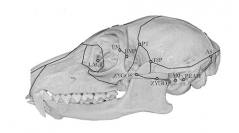

 Comptes Rendus Palevol
9 (6-7) - Pages 423-433
Comptes Rendus Palevol
9 (6-7) - Pages 423-433Geometric morphometric methods constitute a powerful and precise tool for the quantification of morphological differences. The use of geometric morphometrics in palaeontology is very often limited by missing data. Shape analysis methods based on landmarks are very sensible but until now have not been adapted to this kind of dataset. To analyze the prospective utility of this method for fossil taxa, we propose a model based on prosimian cranial morphology in which we test two methods of missing data reconstruction. These consist of generating missing-data in a dataset (by increments of five percent) and estimating missing data using two multivariate methods. Estimates were found to constitute a useful tool for the analysis of partial datasets (to a certain extent). These results are promising for future studies of morphological variation in fossil taxa.
Missing-data, Morphometrics, Estimation, Landmarks